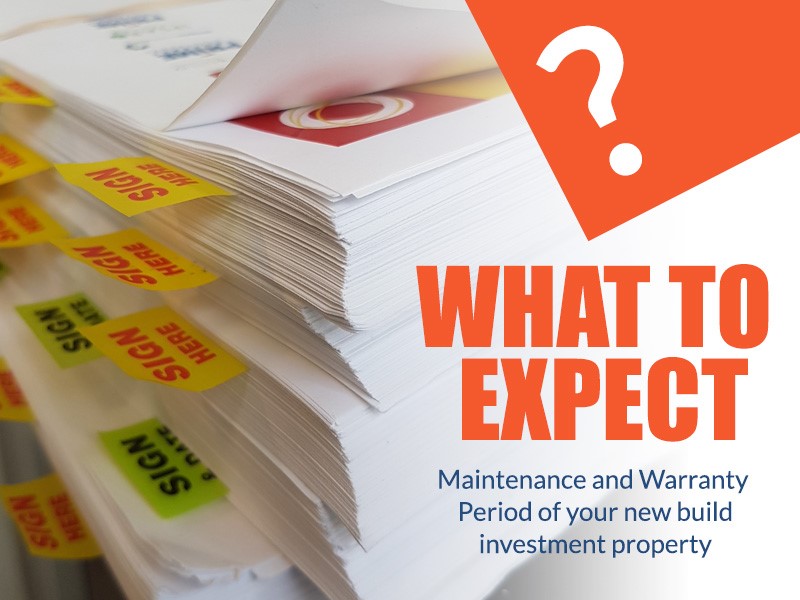Having shiny new working fixtures and clean, well grouted tiles in place is reassuring but how do you know if the property is water tight, when there hasn’t been a drop of rain during the construction period?
You don’t want to find you’re paying out money for roofing repairs once the wet season kicks in because the flashing was defective, but then finding out it could have been covered with the warranty!
One of the greatest benefits of investing in a brand new construction is that your builder is obligated to provide you with new home warranty and maintenance period for a legislated period of time. Here is what to expect during the maintenance and warranty period of your new build investment property.
On the go? Here’s 30 seconds of key take outs:
- The maintenance period, sometimes referred to as the defects and liability period, following handover of your property is your opportunity to call out concerns regarding the construction of your property and have them repaired by your builder. This maintenance period can be anywhere between 13 weeks to six months or longer [as stated in the building contract] starting from handover.
- Depending on the state your property is located in, and the builder you have contracted, warranty periods generally start from a cover of 6 years [NSW]. So with your builder’s warranty you’ll continue to provide cover for ‘structural defects’ and issues arising as a result of the original build.
- As a property investor, you will need to budget for general maintenance of your properties. The costs associated with maintenance will help reduce your tax, keep your asset protected, and your tenants happy. Happy tenants will be more likely to want to renew their lease!Keep reading >>To reach your financial goals, you need your income generating asset to be trouble free in the years ahead, apart from expected wear and tear.
The new domestic build warranty period will give you an opportunity to sort out any nonstandard or faulty work. This warranty period is also referred to as the defects and liability period.
The warranty protects you by making sure your new build is completed; that the structure is finished to agreed specifications; and to meet certain standards.
Question: When does the defects and liability period commence and for how long?
The warranty period varies from builder to builder and state to state. Generally warranty periods start from when your property is handed over and the builder receives the final progress claim for construction, following the practical inspection handover.
In most cases, the maintenance period is between thirteen weeks and six months or longer as stipulated in the contract. What this means is that any maintenance issues or defects that come to light within this period, are the responsibility of the builder to fix and repair, at no additional cost to you.
Usually a representative of the builder will inspect the concerns raised and then detail the next steps to resolve any issues that meet the warranty conditions.
What maintenance issues and defects are covered by the new domestic build warranty?
Houses are built on soil or rock that will shift as the new construction settles into the site. For that reason, minor cracking and shrinkage of natural building materials such as timber frames and roofing trusses is normal.
Minor cracks won’t affect the structural integrity of your property. A crack 5mm or less in width would be considered a general maintenance issue. Make sure you’ve set aside a general maintenance kitty as part of your budget planning.
However, cracks wider than 5mm can be symptomatic of deeper structural issues. According to Building Codes of Australia, a single crack exceeding five millimetres in width is classed as a structural crack.
Common sense prevails in identification of major structural issues. Evidence of leaning or bulging walls within the warranty period would not be expected, and the structural issue would need to be fixed by the builder.
Apart from cracks wider than 5mm in width, defects and liabilities would include any issues that have occurred during the original construction. Any concerns that affect the following should be addressed with your builder as early as possible in the warranty period:
- Incomplete finishes, or finishes that differ from what was agreed in the specifications
- Doors or windows that don’t open or close as expected
- Fixtures or fittings that don’t operate as expected
- Any plumbing or drainage related issues that are causing concern – remember this includes roof gutters too.
- Shoddy workmanship – for example only one coat of paint on skirting boards when you agreed to two or three.
You’ll find reputable, good quality builders will respond well to fixing any concerns during this period. Word of mouth is everything in their trade. So the secret is in finding a great construction crew in the first place.
What general maintenance will you need to factor into your annual budget?
Beyond repairs or remedies covered by the warranty period, or building insurances, here is a list of some of the common general maintenance and repair items you’ll need to budget for and schedule in over time. The more common items include maintenance or repair of:
- Minor wall cracks (less than 5mm in width)
- Cornice cracks
- Plaster shear
- Roof leaks that aren’t a result of storm damage or damage covered by your insurances
- Interior and exterior painting
- Floor coverings. While your tenancy agreement will ensure regular professional cleaning of carpets, there will come a time when the carpets will need to be replaced, or tile grouting needs attention.
Your property is an asset that needs protection. Smoke alarms are mandatory but are pointless if the batteries have run out of grunt.
Here are a couple of handy tips for protecting your property from fire damage. Firstly, make sure testing of smoke alarms and battery replacement are included as a tenant responsibility in the tenancy agreement.
To be doubly sure your asset is well protected, when you schedule a property inspection, arrange to offer to replace the batteries in the smoke alarm, and test each alarm, at least once a year. Your tenants will view you as a proactive, caring landlord. Meanwhile, you’ll be able to sleep well knowing that the smoke alarms monitoring your property are working!
Get some experts around you to help you on your way: Pinnacle Support Program
Free investor tools: About the Pinnacle Support Program






